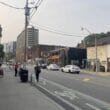Students aged between five and 12 years old from deprived areas are more likely to be excluded from school than children from more affluent areas, The Ferret has found.
We cross-referenced Scottish Government data on exclusions with statistics from Pupil Equity Funding (PEF) – a fund set up to help tackle inequalities – and found schools with higher numbers of exclusions generally get more PEF funding.
Official Scottish guidelines recommend exclusion from school should only take place as a last resort because this can have a detrimental effect and worsen behaviour.
Data published by the Scottish Government in 2017 showed that only 5.7 per cent of students excluded at some point went on to attain level six qualifications or higher.
By contrast, 57.7 per cent of students with no exclusions went on to finish secondary school.
Nick Hobbs, acting children and Young People’s Commissioner Scotland, said he backed a recent UN report which called for a prohibition of exclusions at UK primary schools.
The Scottish Government said it recognises the “significant impact” that exclusion can have on children and that schools should strive to prevent this, where possible.
If children are not in school they are not learning – and whilst exclusions serve a purpose – they are not the only way to tackle challenging issues.
Glasgow City Council
Figures on school exclusions, analysed by The Ferret, are published every two years by ministers, with the most recent data covering 2018-19 and 2020-21.
Shortlees Primary School, in East Ayrshire, was top of the list in 2018-19 with 60 exclusions. In 2020-21 – a year when schools remained closed due to the pandemic – Shortlees excluded 18 students, the second highest number in Scotland.
For data protection reasons, it is not possible to access data on the excluded students’ socioeconomic background. However, The Ferret analysed other data to determine whether exclusions were affecting particular groups of students.
One of these sources was Pupil Equity Funding. Typically, schools that receive more PEF funding tend to serve underprivileged populations.
Official PEF figures show Shortlees Primary was top of that list, with over £300,000 funding in 2021-22.
Of the top 25 schools with core funding under PEF, only 10 excluded fewer than five students.
Schools that have excluded fewer than five students are not included in the statistics. While the 2020-21 school year was significantly affected by the Covid-19 pandemic, there were still 654 exclusions registered in Scottish primary schools. In 2018-19 there were 2207 exclusions.
The 10 schools that excluded the most students in both of these years combined are:
| Shortlees Primary School (East Ayrshire) | 78 |
| Pathhead Primary School (Fife) | 43 |
| Lawfield Primary School (Midlothian) | 40 |
| Hawthornden Primary School (Midlothian) | 33 |
| Granton Primary School (City of Edinburgh) | 32 |
| Hillhead Primary School (East Ayrshire) | 32 |
| James Hamilton Primary (East Ayrshire) | 30 |
| Cornhill Primary School (Aberdeen City) | 29 |
| Fernielea School (Aberdeen City) | 29 |
| Obsdale Primary (Highland) | 29 |
The PEF programme depends on voluntary applications by schools, so it may not provide an accurate representation of relative deprivation of school communities across Scotland.
However, three of these schools are in the top 25 most funded schools under the programme, and six were awarded over £100,000 in 2021-22.

The Scottish Index of Multiple Deprivation (SIMD) also makes it possible to identify where communities experience disadvantage, such as access to healthcare and employment
The SIMD shows that seven of the ten schools which excluded the most students are in the 30 per cent most deprived areas of the country.
Obsdale Primary in Alness is the only one of these schools in an area that is among the least deprived 50 per cent of Scotland.
Only three of the top 25 schools with the most exclusions are in the top half of the SIMD. This means the vast majority of schools that exclude more students are in deprived communities.
East Ayrshire Council – which runs three of the top 10 schools, including Shortlees – said it was “fully aware of the research on exclusions and the adverse impact they can have on individuals, and our practice is in keeping with Scottish Government’s policy.”
Data published by the Scottish Government “identifies that there has been a reduction in exclusions between 2018-19 and 2020-21 across East Ayrshire schools and our schools have worked hard to prevent their usage,” said a spokesperson, who did not clarify if this reduction was impacted by the Covid-19 pandemic.
Data for Glasgow paints a different picture. Although 12 of the 20 schools with more funding under the PEF programme are within the city’s council area. 22 of the 40 Scottish schools with more PEF funding are in Glasgow and yet, none of them reported having excluded more than five students in these two school years.
Schools must have robust human rights-based support plans, created with children and their families.
Nick Hobbs, acting Children and Young People’s Commissioner Scotland
A spokesperson for Glasgow City Council said: “Glasgow has for many years been working on reducing the number of exclusions and you will see this from the massive percentage drop over the last 15 or so years. If children are not in school they are not learning – and whilst exclusions serve a purpose – they are not the only way to tackle challenging issues.”
In June, the UN’s Committee on the Rights of the Child published a report with recommendations for the UK on the rights of children.
It said exclusions should be prohibited in primary schools and used in secondary schools only as a “measure of last resort”. The authorities should “develop measures to address their overuse in general as well as their disproportionate use on children belonging to ethnic minority groups and children with disabilities,” the report added.
Nick Hobbs, acting children and Young People’s Commissioner Scotland, backed the UN report. He told The Ferret: “Any child’s behaviour needs to be seen as communication. Adults should be considering if that communication is being caused by unmet needs or unrecognised trauma and what supports should be put in place to help.”
Hobbs added: “The Scottish Government must ensure that schools are provided with sufficient resources and that teachers and support staff are enabled to meet the diverse needs of all children.”
A Scottish Government spokesperson said: “We recognise the significant impact that exclusion can have on a young person’s learning and future outcomes – that is why our guidance for schools ensures that there is a strong focus on supporting positive behaviour to prevent the need for exclusion.”
Asked whether all schools in Scotland followed this guidance, the spokesperson said guidelines were “available to every school and that is the national approach”.
Some experts believe that school exclusions may exacerbate risk factors that lead to problematic behaviour, even if they are used only in extreme situations.
Main image: monkeybusinessimages/iStock














